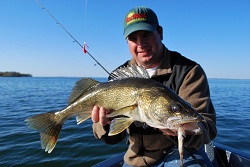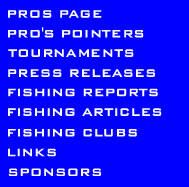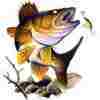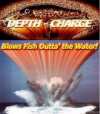Live bait rigging is all about angles. The amount of weight on the sinker combined with the amount of line out determines the angle that the line takes from the rod tip to the water. The direction that you hover or move either across structure or up and down through structure determines the angle that the boat has to cross structure to catch the most fish. Master the angles and you catch way more fish with live bait rigs, plain and simple.
 |
There are several ways to adjust sinker weight that have come and gone over the years but to this day, the simplest and most effective system I know of is the simple blade change clevices used for quickly changing spinner blades on harnesses. The Northland Roach Rig Walker Sinkers are what I have been using for years just because the sinker has a wire eye that will clip into the clevice. |
You can pop these weights on and off, yet the line still slides through the weight easily if you want to feed fish line. If you are in heavy snags, rig the clevice backwards so the plastic arm bends enough to where the sinker pulls off, this enables you to pop out of a snag where you just have to replace the weight. On snaggy bottoms with a lot of debris, the Rock Runner Slip Bouncer works well but the key for fishing either sliding bottom bouncer sinkers like Rock Runners or traditional walking Roach Rig sinkers over heavy snags is to keep the rig vertical fishing below the boat where the sinker or weight isn’t dragging the bottom. In heavy snags, contact the bottom sporadically to find a reference point and than lift and swim the weight above the bottom, only allowing the bait to swim back down to the bottom, this greatly reduces your snags.
The beauty of rigging, however, is that you can fish vertically over mud, heavy snags and rock like described above or let out more line and fish horizontally away from the boat, dragging live bait over sand or gravel…. Basically any type of structure. If you are getting out fished by another rod in the boat, the first and easiest adjustment to make is the “angle” that can determine success. The amount of line out determines the angle of the line from the rod tip to the water. The angle of the line should be the most important adjustment to experiment with.
Assuming that you are on the bottom or close to the bottom, why would the amount of line out or line angle affect success? There are a couple of factors that seem to greatly affect my success with a live bait rig. First, distinguishing bites from the bottom often means the difference between catching a lot of fish and catching none. If I am making constant heavy bottom contact where the rod tip is always loading, a bite often feels like just another bump or hang up on the bottom until the bump gets mushy and moves. On a tough bite, the fish drop the bait with the increased resistance. The amount of line out can either increase or soften the magnitude of bottom contact that is almost like electrical interference to audio when it comes to bite recognition. This is much more important than the kind of rod or line you are using because remember that a good graphite rod with the right line is only going to increase the sensitivity, increasing the clutter and contact you feel on the bottom. On a really tough bite where the fish aren’t holding and running with the bait, you want to tune out as much bottom contact as possible. By having this better feel, you can do either two things…. Feed the fish line or drag the fish a short distance forcing the fish to hang and suck down the bait.
Most of the time when I am live bait rigging in less than twelve feet of water; I am typically fishing shoreline contours or flats. With that being said, I like to run live bait rigs out further from the boat on flats and also shallow water. If fish are bumping from the presence of the boat, your electronics will often tell you. If you are not marking fish below the boat for example, run the rigs further back. If the marks are more vertical and taper down sharply on the right hand side as the mark scrolls across the screen, these fish are bumping off the boat. On the other hand, if the mark scrolls across a good portion of the screen and is more of a horizontal flat line or symmetrical arch, than the fish is below the boat and holding below the boat. If fish are below the boat or if you are trying to stick contours and break lines, fish below the boat.
Bass anglers often preach the importance of casting angles… hitting a likely target from numerous angles in order to find the window where the bass will strike. Walleye fishing can be similar in the fact that there is sometimes a productive direction or angle that the presentation should move in order to catch more fish. The magic direction or angle might be to pull the rig up the break or slide along the shelf while following the contour. On structure, an angler has a few options to experiment with. One option is to follow the contour with the ambition of holding or staying on a specific break, depth or transition. The other option is to move up and or down the break or contour at different angles until the sweet spot is found. I can only guess that some of these phenomena might relate to the fact that fish often position is a way where they might all be facing the same direction.
Some of these observations have greatly affected and influenced my own fishing success and I place more importance on these particular adjustments than any single piece of equipment that I could buy in hopes of enabling me to catch more fish.
Editors Note: The author Jason Mitchell hosts the popular outdoor program, Jason Mitchell Outdoors which airs on Fox Sports North on Sunday mornings, 9:00 am. Before television, Mitchell earned a renowned reputation on North Dakota’s Devils Lake as a fishing guide.







